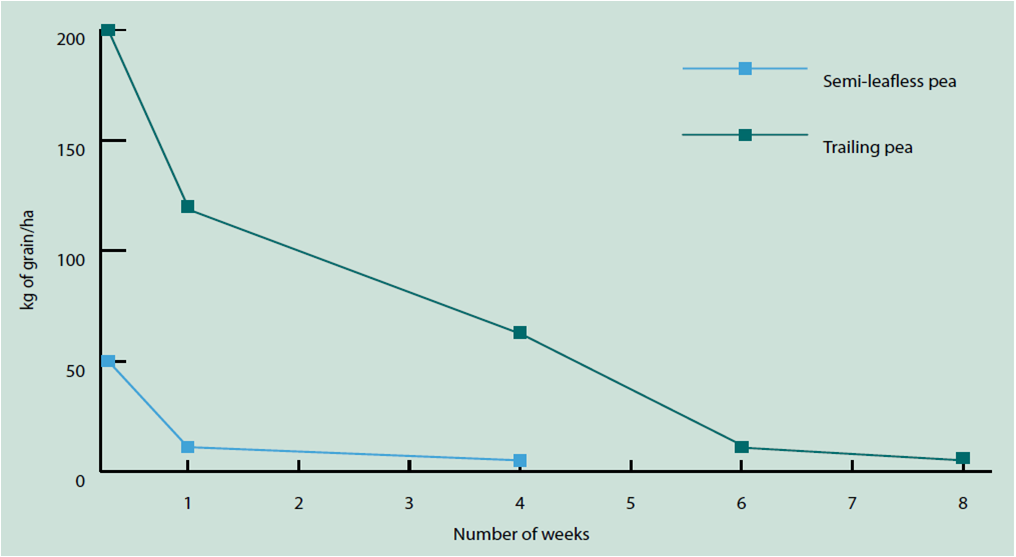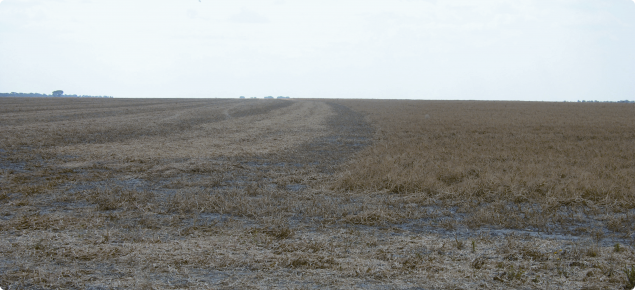Manage field pea stubble
Grazing stubble can loosen 40t/ha or more of surface soil. Light soils such as sandy-surfaced duplex soils may lose much more. Wind tunnel tests show that field pea stubble has few soil erosion problems if left ungrazed and uncultivated.
Reducing the amount of spilt grain reduces the need to graze field pea stubble. Improving harvest efficiency or decreasing harvest losses will decrease the need or duration of grazing and consequently decrease the risk of wind erosion.
Retaining as much cereal straw as possible also reduces the risk of wind erosion. The straw helps to anchor the field pea stubble after harvest and increases the amount of surface cover of the soil, whether it is grazed or not.
Loose field pea stubble can build up against fences, which is unsightly and may damage fences. Using a harvester fitted with choppers and spreaders helps to prevent this build-up. It is best to harvest on days when the residue will chop into small pieces and spread evenly rather than form long vine-like ‘sausages’ or mound to create lumpy paddocks.
Semi-leafless field pea varieties with the sugar pod trait have a ropey vine which is more likely to form ‘sausages’ than conventional trailing varieties particularly in cool weather.
The no-grazing option
For wind erosion control, the safest option is not to graze the stubble. The soil surface is left relatively intact after harvest. A summer rain may form a stable surface crust which lessens the risk of wind erosion.
Although this option may seem to waste good summer feed, it reduces the risk of soil and nutrient loss. Cereal yields are increased in the next season by keeping as much pea stubble on the paddock as possible. One trial has shown that when field pea stubble is left ungrazed, wheat yields can increase by 9% and grain protein content increase by 2%, compared to wheat grown on field pea stubble grazed for about five weeks.
If the field pea paddock is not grazed some stubble management may be required to prepare the paddock for the following cereal crop. Options include cultivation, raking and baling, raking and burning and collecting crop residue at harvest.
Cultivation
A common management plan is to cultivate stubble after summer rain or, if the stubble has been grazed. Cultivation incorporates the field pea stubble into the soil which helps when seeding the next cereal crop and produces a ridged surface that is less liable to erode.
Raking and baling
Field pea straw can be raked and baled immediately after harvest. The baled straw is then fed back when needed onto cereal stubble paddocks. However, field pea straw will be a source of blackspot disease when spread to other paddocks. Raking loosens the soil surface and removing the straw leaves the paddock with little protection, exposing it to a greater erosion risk.
Raking and burning
Field pea stubble can be raked and burned just before seeding. Raking and burning exposes the surface to erosion, but usually only for a short time.
Collecting crop residue at harvest
Several machinery manufacturers produce catcher bins to collect riddle material from harvesters. This material includes weed seeds and seconds grain and has a nutritional value roughly equal to good quality hay. It can be fed to stock in other locations, on its own for maintenance or mixed with grain for growth. This removes the need for grazing.
The grazing option
Nutritional value
The leaf, stem and grain components of field pea stubble are of higher nutritional value than cereal stubble but not quite as good as lupin stubble in terms of protein and energy (Table 1; Table 2). As with all stubble, sheep prefer to eat the most digestible part first, starting with grain, leaf, pods (or husks) and then stems.
| Crop | Average crude protein of leaf, stem and grain (%) | Average digestibility of leaf, stem and grain (%) |
|---|---|---|
| Fieldpea | 6 | 50 |
| Lupin | 7 | 58 |
| Wheat | 2.5 | 45 |
| Component | Field pea | Lupin | Oats |
|---|---|---|---|
| Starch (%) | 24.5 | 0.2 | 29.6 |
| Crude protein (%) | 22 | 28 | 10 |
| Metabolizable energy (mJ/kg) | 13.4 | 13.2 | 12 |
The amount of residual grain in conventional trailing field pea stubble ranges from 100-250kg of grain per hectare (50-125 seeds/m2), of which 40-90% is accessible to grazing sheep. At stocking rates of 6-10 sheep per hectare, sheep will use the majority of the grain in a field pea stubble containing 200kg of grain per hectare in about four weeks (Figure 1).

During this period, sheep growth rates can be close to the maximum because of the high grain intake. For Merino weaners and adults this is about 180-240g per head per day. Once the majority of grain has been eaten, the nutritional value of the remaining material is likely to be below maintenance value and the sheep will lose weight quickly.
With the correct header set up, harvest losses in semi-leafless field pea paddocks are below 100kg of grain per hectare. At this relatively low amount of grain, sheep will be much less efficient at picking up the grain and it is unlikely the paddock could be grazed for more than a few days, during which time sheep may lose condition. There is no value in grazing field pea stubble once the majority of grain has been eaten.

